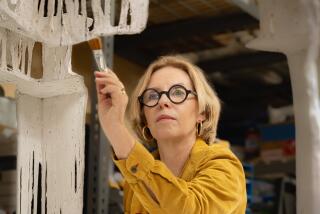A Dying Art: Bringing Dolls Back to Life
- Share via
BUENOS AIRES — Antonio Caro practices a dying art: bringing sentimental keepsakes back to life. His doll workshop is piled high with porcelain heads and plastic arms and legs.
Many of the thousands of limbs are dusty from years of waiting for customers, who no longer flock in as they did when handmade dolls were prized toys of little girls.
Argentina’s doll factories died out decades ago and Caro, 77, is one of the last of those who restore antique dolls. He can reset doll eyes so they move like real ones, sew back hair and mend the gizmos that bring squeaky doll voices to life.
In the House of the Dolls, the gray-haired Caro sits quietly in the gloom, eyeglasses perched low on his nose, as he fixes a plastic doll that was made in China.
Plastic, he says, ruined the market for quality, old-fashioned dolls.
Plastic dolls that began flooding Argentina in the late 1960s snuffed out demand for more expensive porcelain, plaster and papier-mache dolls that were made and painted by hand. The trade had kept many a craftsman in good money through the 19th and 20th centuries.
Along with plastic came changing times and customs. Children still play, but Caro says they seem to grow up faster, shedding dolls more quickly for flashy computer and video games and such.
“All the doll factories are now gone, completely gone,” says Caro, seated at a dented wooden workbench where a dim bulb lights his labor.
Still, people trickle into the shop all day.
Grown women ask him to repair cracked antique dolls handed down by grandparents.
“My father gave me this as a child and he has passed away. Can you fix this doll?” a woman implores him.
Collectors seek advice on locating rare dolls, and shopkeepers seek handmade dolls to sell to tourists. Even little girls bring dolls in need of a fix-up.
Still, Caro longs for dolls from another era: bouncy Marilu, who was the rage in Argentina after World War II, or Shirley Temple, the favorite between the wars.
He still has plenty of the 3,000 porcelain doll heads that his father bought at auction in 1918. He uses them to repair the occasional antique, but says wryly: “I think they’ll still be here when I’m gone.”
“Truth be told, I was born in a house of dolls,” says Caro, whose father got into the work early in the last century. His family once had three shops in Buenos Aires, all fixing dolls and producing mannequins for seamstresses and tailors.
Few in Buenos Aires still know the art of antique doll repair, so Caro finds his services in demand.
“Very few these days can paint by hand and get the cheeks, the background hair and the eyebrows just right,” he says. “It takes real practice.”
Caro and his wife reared three girls who went to college and entered other professions. None is taking on the business.
Alone in his shop, he sits alongside a sewing machine specially designed to stitch little wigs.
Backed by hundreds of doll legs and arms rising up the racks, he looks out the window and sighs. “Once upon a time, this was a very good business.”
More to Read
Sign up for Essential California
The most important California stories and recommendations in your inbox every morning.
You may occasionally receive promotional content from the Los Angeles Times.










